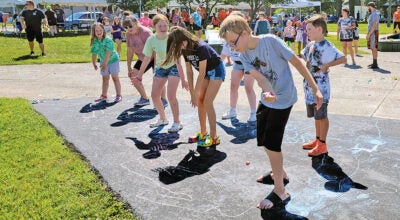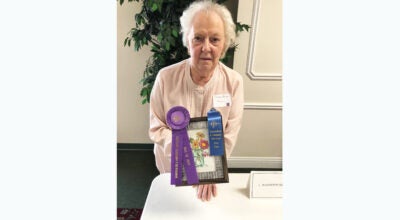Riverfront development plan moves forward
Published 12:10 am Sunday, November 17, 2013
Developing the riverfront in Ironton is a matter of dollars and sense: Dollars to complete the project and the sense to do it efficiently.
“Each step in the development enhances the other steps,” Rich Blankenship, mayor of Ironton, said. “The master plan is in place and we know what we want to do.”
The development project has been in the works for five years and includes a marina, the development of remediated property, a pocket park and a shared trail system as its four key components.
“There is an ongoing effort toward citywide improvement. This is just one area,” Blankenship said. “With everyone working together, all this will come together easily.”
The goal is to get the project done quickly, Blankenship said, but with the best benefit for the people of Ironton. Blankenship has roughly two years remaining in his current term and is optimistic, yet realistic, about its progression.
“I plan to see this project 80 percent complete by the time I leave office,” he said. “I know how long these things take, so I know it won’t be 100 percent complete. All these projects are multilayered, and they’re all different.”
Grant money in place
Four grants are in place for the overall project and the current phase — a bicycle and walking trail — is progressing because of $100,000 in grant money administered through the Ohio Department of Natural Resource’s (ODNR) NatureWorks program.
“All of our grants are working together in order to reach our objective,” Blankenship said. “A key component of any project is having the grants in place, and even then these things take time.”
Of the four grants, two are through ODNR. One is a Clean Ohio Trail grant and the other is through the United States Department of Fish and Wildlife. Blankenship said another grant application has been submitted to ODNR.
“A $208,000 match has been appropriated by the Lawrence Economic Development Corporation (LEDC),” he said. “Getting 100 percent of the money is rare when the amount is large. We can and will offer in-kind matches of labor and things like that as well.”
The first grant awarded in the process was for cleanup and the $630,000 grant from the U.S. Department of Fish and Wildlife’s Boating Infrastructure Grant Program (Big P) for marina construction, was applied for twice.
“Competition for the Big P grant is nationwide,” Blankenship said. “We got approved for it the second time and we are very fortunate to get it. Ours was one of only 16 grants awarded.”
A $500,000 grant for cleanup was the first step in the process, which Blankenship credits as the most time-consuming aspect of any project.
“When one grant is awarded, apply for the next grant,” he said. “We have gotten four grants. We have four plans. The grants are from four different agencies and each agency has different requirements. If you look at the big picture it seems easy to do these projects, but it’s not.”
Current project
One of the projects four phases is underway; a shared trail that stretches from Second Street at Storms Creek to the old marina area.
“It’s just a part of the whole,” Blankenship said. “People often ask ‘Why trails?’ and I tell them trails are vital to improving our riverfront and using it as a recreational area and enhancing it in preparation for future development.”
The original anticipated completion date of phase I was the end of this year, but Blankenship requested, and was granted, an extension because of the seasonal closings of the asphalt plants.
“It should be finished by spring,” he said.
Bid opening for the trail project is Wednesday, Dec. 4.
Marina
The $630,000 Big P grant will be used to construct a marina at the riverfront.
Blankenship has taken steps toward not only getting the highest quality marina for the lowest cost, but ensuring once it is in place it is utilized.
“It is imperative the design of the marina meets the needs of both transient and local boaters,” he said. “We have to give boaters a reason to stop at our marina.”
Blankenship made calls and took trips to other marinas in his quest to determine what Ironton’s marina should and shouldn’t encompass.
“I just asked people at other marinas about the do’s and don’ts,” he said. “If we find out beforehand what works and what doesn’t it will save us time and money in the future.”
After contacting marina and government personnel in Point Pleasant, W.Va., New Richmond, Ohio, and Chilo Dam, Blankenship said he learned putting wheels on the 30-slip dock will make it much easier to take it in and out of the water and placing trash booms upriver to divert debris buildup are two small, but key elements.
“There are no marinas between Holiday Point in Franklin Furnace and Huntington, W.Va.,” he said. “We need to offer sewage pumping, ice, food and other reasons for boaters to stop.”
Blankenship is currently looking at different manufacturers to determine the best quality material from which to build the dock.
Economic development
A Clean Ohio Revitalization Fund (CORF) grant of $1.5 million was used to clean debris and reverse any environmental damage done to a five-acre section of the riverfront. This area is where city officials are planning the riverfront’s economic development hub.
“There was a lot involved in the remediation of that section,” Blankenship said. “There are borings, tests and compacting that have to be done and they have to meet Environmental Protection Agency requirements.”
Developers have been contacted about the site, Blankenship said, and he is currently searching for potential investors. Some possibilities being discussed are condominiums, retail shops and restaurants.
Pocket park
A vacant lot sits on the riverside of Second Street and Storms Creek. It’s an area that the mayor feels has been not only underutilized, but slightly abused.
“We have some people who use it to go fishing or to sit there and eat lunch,” he said. “Then, like anything else, there are people who mistreat it.”
The plan is to clean up the lot and transform it into a pocket park with a recreation and picnic area.
“It’s very visible and has a very good view of the river,” Blankenship said. “It’s not a very big area, but it is not utilized as it should be. It could be more attractive.”
Trail system
A grant from the KYOVA Interstate Planning Commission will be used to develop later phases of the project’s shared trail system, which will eventually extend from Center Street to Storms Creek.
“We are looking as thouroughly into the trail system’s future phases as we are all other phases and all other projects,” Blankenship said. “We have to determine what material to pave with, what type of lighting to install and where to put benches, among other things.”





